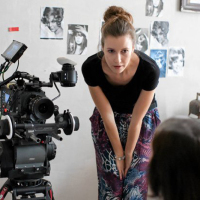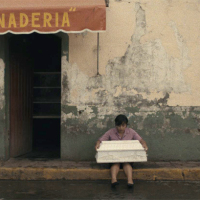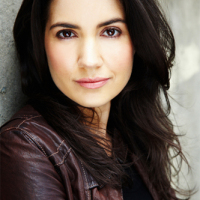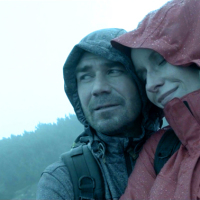
By Heidi Simmons
The Palm Springs International ShortFest screened 330 films from around the globe. Of those short films, 94 were made under the creative guidance and inspiration of women.
“That number represents a definite rise in the number of women represented with their films in the ShortFest lineup this year,” said Darryl Macdonald, Festival Director. “The past few years, films by women directors have accounted for roughly 20 – 25% of the films in the ShortFest lineup. This year, it’s closer to 30%, so it’s definitely a rising trend.”
Macdonald said the Festival is seeing an up tick in the number of films submitted to ShortFest in general – some 200 more films this year than last, but the Festival don’t track how many of the films submitted are made by women as opposed to those submitted by men. (There were over 3000 submissions.) The figure also doesn’t include other creative roles by women such as writers and producers.
“The filmmakers’ gender plays no role in our selection criteria or process; we strive to select what we consider to be the best examples of short filmmaking we receive, so the only criteria we use is excellence – in terms of storytelling quality, stylistic and technical adroitness,” said Macdonald. “I can tell you that our selection committee includes more women than men, and among the core group of programmers there are two women and two men, so I think overall, both genders are equally well-represented when it comes to film selection for the Festival.”
Filmmakers Agnieszka Maskovic and Barbara Cigarroa share what inspired their films, why the craft of filmmaking matters to them and the importance of the PSISF.
Writer and director Agnieszka Maskovic’s “Miranda” (Poland, 28 minutes) is a crisp black and white film about a blind young woman who never leaves her father’s apartment and then meets a new tenant who shows her a new and wonderful world. Beautifully photographed and artfully told, the film is poetic.
Maskovic and her husband attended the ShortFest together from Poland. “Miranda” was inspired by William Shakespeare’s The Tempest. Regarding what drew her to filmmaking Maskovic said, “Different people have different talents. As we discover our possibilities we start developing them, but we never know where the passion will lead us. I was six when I started playing the piano at music school, later I started writing poems and short stories. I was never afraid of trying new things that were a challenge. This year I finished theater school as a stage director. Making movies was something extraordinary in my school. I just wanted to try something new, and that was an exciting task for me. It combines most of my passions in a very special way.”
Honored to be a part of PSISF and proud of her creative filmmaking team, Maskovic said, “This is the best festival I have ever been a part of. I hope this will give us more energy to work twice as hard!”
Maskovic is preparing for her stage debut and is writing her first feature film. “I am open to all creative surprises.”
Director Barbara Cigarroa’s “Marta Rosa” (USA/Mexico, 9 minutes) tells the story of a young grieving mother who must come to terms with the loss of her small child. Filmed in Mexico, the story has minimal dialogue. Cigarroa won Best Student Live Action Short and the Jury Award – Panavision Best North American Short.
Cigarroa comes from a creative writing background. As an undergrad she studied fiction and playwriting. “I’ve always loved putting words down on paper and imagining different worlds and the people within them,” said Cigarroa. “I wanted to see whether I could try to take these realities I created with words and adapt them to film. I fell in love with directing soon afterwards, discovering different tools –visuals, music, rhythm – I could use to try to touch an audience.”
Her passion for storytelling is an emotional response from reading and watching movies. Cigarroa said, “I am fascinated by the way all stories allow an audience to empathize with characters and circumstances that, even though foreign, can be universal. I want to make films that everyone around the world can feel and experience.”
“Marta Rosa” was inspired by a photograph by Enrique Metinides that shows a Mexican woman walking down a busy street in Mexico City with a small coffin in her arms. “The image struck me,” said Cigarroa. “I became fascinated by this person. Tania Zarak wrote a beautiful and touching script. We wanted to create the story of a woman who could be strong in the face of heartbreaking tragedy, but who must ultimately keep moving forward and persevere.”
Cigarroa’s experience at Shortfest has been rewarding. “It’s our world premiere and we couldn’t have asked for a better event to screen it for the first time,” said Cigarroa. “The feedback has been wonderful. It’s so great to speak to different filmmakers from around the world. I have also made contacts with programmers, casting directors and buyers that have shown interest in our project.”
Cigarroa is in pre-production for another short film called “Flight of the Fields.” This one is about a migrant farmworker in upstate New York and her experience trying to leave the harsh and often unfair working conditions of her job. “I am also working on a couple of feature film scripts that I hope to shoot in the near the future.”
Below is a small sample of what women filmmakers made from around the world that were included in the ShortFest:
“Silent Night” (Australia, 11 minutes). Written and directed by Nastassja Djalog is about Australian society in 2036 euthanizing those who are a financial burden on society.
“The Trail” (Germany, 34 minutes). Written and directed by Elke Brugger tells the tale of a couple who abandon their lives in the hope of a future together.
“Ballon” (South Korea, 5 minutes). Co-written and directed by Sang-eun Han and Si Dong-joo is an animated story about a young man who falls in love with a balloon girl.
“Fernweh” (Netherlands, 14 minutes). Written and directed by Ena Sendijarevic is the story of a young girl who realizes there is a life beyond her family and farm.
“We make an effort to include a broad demographic mix of filmmakers and a diverse national mix of films for the lineup, as well as a number of other factors such as genre and originality,” said Macdonald. “The final selection of films is based strictly on the quality of the filmmaking evidenced as we watch and grade the films on the basis of the writing, direction, acting, production qualities, etc.”
As far as a directorial genre balance in Hollywood filmmaking, Macdonald says that Hollywood is an industry largely run by men who are making movies primarily for a young male demographic.
“In other parts of the world – many European countries, for example – women are much more able to gain access to the funding and support required to make feature films,” said Macdonald. “But in this country, until the Hollywood film industry’s perception of what the audience wants to see changes, we’re likely to see more of the same, testosterone-fueled filmmaking that has dominated screens for the better part of the last two decades.”
Macdonald also pointed out – which is often overlooked – the number of women active in producing films for the US market. “A great number of the strongest and most acclaimed film producers in the business are women,” said Macdonald. “That fact alone should help the industry begin to redress the disparity in the number of women as opposed to men who are actively directing feature films in America. However, I expect it to be a very long term process.”
Kudos to the Palm Springs Film Festivals for seeking and supporting all talent and providing a place for new voices in filmmaking for both men and women.

















































